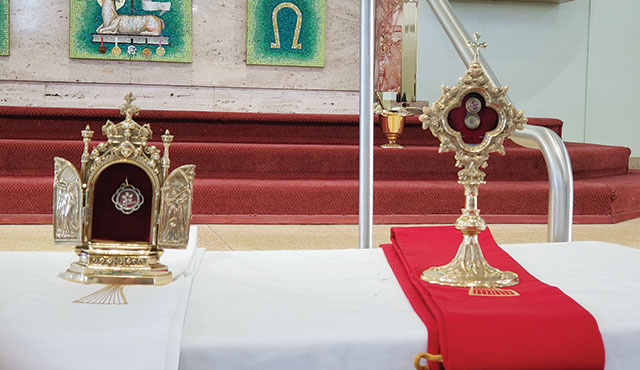Their bodies were frail, but their spirits were strong and pure. And now Saints Maria Goretti and Thérèse of Lisieux are connected to St. Polycarp Catholic Church in Stanton in both body and spirit.
The physical connection to the two saints from the late 19th and early 20th centuries was made thanks to the donation of a relic from each saint from a parish family that chose to remain anonymous. The two relics had been family heirlooms that the donors decided to share with the congregation.
On Saturday, Oct. 5, congregants at St. Polycarp got their first chance to view and venerate the two first-class relics, or relics that are actual body parts from the saints, as they were unveiled at a morning mass.
“These are quite special,” said parish priest Father Michael St. Paul.
On Wednesday, a stained glass window depicting Saint Maria Goretti had been installed, giving Fr. Saint Paul a perfect reason to unveil the two relics. The church has long had a statue of Saint Thérèse of Lesieux in an alcove near the rear of the church.
Relics are important in Catholicism as tangible connections to saints and objects of veneration, which is a form of admiration and honoring that is only below adoration, which is the highest form of worship and reserved for God.
The relics of St. Maria Goretti and St. Thérèse are the first for St. Polycarp. They will be kept in a secure place and made available for special occasions, such as the saints’ feast days, according to Fr. St. Paul.
Parish youths Natalie Ngo, 14, and Hector Lobato, 18, held the relics aloft entering mass and placed them on a table next to the altar.
Ngo said she was honored to be chosen to carry in a relic and admitted she was scared she would drop hers.
Likewise Lobato, who has been a parishioner from birth, called the honor of presenting a relic “special.”
The two relics, were slivers of what looked like bone. St. Maria Goretti’s was a tiny disc about a 1/16th inch in diameter. The relic of St. Thérèse, who was nicknamed “Little Flower,” was slightly larger and carved in the shape of a four-petal flower.
Both relics were housed in ornate, gold-plated reliquary. St. Maria Goretti’s relic was encased behind glass atop a candlestick-shaped base, while that of St. Thérèse was behind the doors of a facade.
Fr. Saint Paul said the two saints were “sources of innocence and chastity,” and a reminder to “come like little children to Jesus.”
After the Mass, more than 100 congregants in two lines queued up to venerate the relics. Many knelt before the relics, some touched the reliquary with personal objects and, in a sign of the times, some took close-up photographs with their phones.
Fr. Saint Paul was struck by the transformation his church has undergone in less than a year. In February, the church began replacing its monochrome windows with stained glass mosaic windows donated from the chapel of Daniel Freeman hospital before it was demolished.
The window containing the image of St. Maria Goretti was part of the window-installation project’s second phase.
St. Maria Goretti was born in 1890 and is believed to be the youngest saint in the Church. A virgin martyr, she died tragically from knife wounds suffered fighting off an attempted rape in 1902. She survived in the hospital long enough to identify and forgive her attacker, saying she hoped he would join her in heaven.
She was canonized in Rome in 1950 by Pope Pius XII. A crowd of 500,000 attended, including youth from around the world, forcing the ceremony to be moved outdoors to St. Peter’s Square.
St. Maria Goretti appeared to her attacker while he was in prison and again forgave him. It was a turning point for the man, who repented, begged forgiveness and, after serving his sentence, became a Franciscan lay brother.
Saint Thérèse of Lisieux was born in 1873. She became a Carmelite nun at the young age of 15, one of four sisters to enter the convent. She was just 24 when she passed away after battling tuberculosis.
However, she wrote so compellingly about her beliefs and faith in her autobiography, “Story of a Soul,” that she became one of the most popular modern saints.
“What matters in life,” she wrote, “is not great deeds, but great love.”
She was canonized in 1925 and Pope Pius X called her “the greatest saint of modern times.”
As Fr. St. Paul watched the line of congregants stretching to the back of the church and waiting for a chance to venerate the relics he reflected on the past year.
“It never ceases to amaze me, the faith of my flock,” he said, “It’s moments like this that bring me back. I learn from them.”

